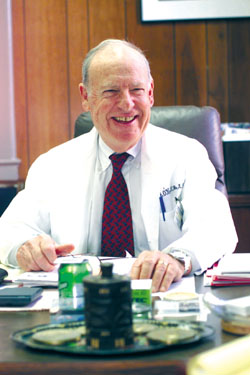
Genome ethics topic of recent grand rounds
Researchers grasped the human genome by the tail and are now reaching for proteomics, the study of how proteins carry out the body’s functions. But science, and the general public, are just beginning to conceive of this study’s ethical, social and legal ramifications.
“My view is, now that we have the genome mapped, we realize how little we know,” Dr. Ellen Wright Clayton, professor of Pediatrics and Law and Rosalind E. Franklin Professor of Genetics and Health Policy, said last week. “This is even more complex than we thought.”
Clayton spoke following the spring ethics grand rounds, held April 10 in Light Hall. She and Dr. John A. Phillips, III, David T. Karzon Professor of Pediatrics and director of the Division of Medical Genetics addressed the topic, “The Human Genome Project: What Is It and How Will It Affect Us?” Cindy L. Vnencak-Jones, Ph.D., associate professor of Pathology and Pediatrics and director of the Molecular Genetics Laboratory, moderated the discussion.
The grand rounds was one of two annual events sponsored by the Ethics Committee. They are designed to generate discussion and reflection on an integral part of – not a separate study from – medicine, said Dr. Frank H. Boehm, professor of Obstetrics and Gynecology, director of Maternal/Fetal Medicine and chair of the Ethics Committee.
“We felt that the Human Genome Project, with all its ethical ramifications for the future, is going to present a whole host of concerns, issues and controversies that doctors, nurses and the rest of the staff need to consider,” Boehm said.
In the presentation, Phillips explained that each of the 10 trillion cells in the human body contains about 5 feet of DNA – if added together end-to-end, enough to reach from the earth to the sun about 90 times.
Last summer, Celera Genomics announced it had sequenced one human’s genome. Vanderbilt became the first academic institution to purchase the biotechnology company’s findings for use in research. On April 4, three companies announced they will spend up to half a billion dollars to identify all the proteins in the human body and all the interactions between those proteins.
But despite the abundance of information, and science’s perceived ability to interpret it, broader reaches of the genome will prove to be more difficult riddles to unravel.
“The Human Genome Project will raise more questions,” Vnencak-Jones said. “Will we allow insurance companies to profile people? How are we going to decide what’s right and what’s wrong? Who decides?”
“Science isn’t going to answer these questions,” Phillips said.
Among the issues being batted around, Phillips and Vnencak-Jones said, is the public’s perception that identifying a gene or genes responsible for diseases will quickly lead to cure.
“The gene for muscular dystrophy was cloned in 1985, but we still can’t do anything to cure the disease,” Vnencak-Jones said.
Likewise, Phillips said, requests for “predispositional tests,” to identify genes associated with diseases such as cancer, stir up more questions.
“There are at least two genes responsible for breast cancer – BRCA 1 and BRCA 2 – and probably more,” he said. And there are many different changes in genes that can cause colon cancer. What do we do with a predispositional test that identifies genes associated with colon cancer?
“Do we monitor the patient frequently? Do we tell the insurance company? Do we tell him to have his colon taken out? There are no guarantees,” Phillips said. “We all have eight to 10 genes that are bad – a genetic flaw in the genome. If we live long enough, we’ll find out what those are.”
Genetic testing already has flushed out legal cases. On April 5, Burlington Northern Santa Fe Railroad settled a case in which they agreed to stop genetic testing, and to destroy tests already reported, on workers. The tests, performed secretly, looked for chromosome 17 deletion, which has been suspected of causing some forms of carpal tunnel syndrome.
“First, we need to ask, ‘Is this test stupid?’” Clayton said. The Burlington Northern test, she said, was, because people who have the mutation that was being sought have numerous other symptoms as well.
“If it’s not stupid, we have to ask really fundamental political questions about who gets to decide what to do with the information. But before we get that far, it’s important at minimum to get rid of the dumb stuff,” she said.
A case against Johnson Controls, in which the lead battery manufacturer tried to exclude fertile women from its workforce, set a precedent that an element of risk does not result in an obvious response. It concluded that the risk is up to the individual to decide, and not a point by which an employer can exclude workers, Clayton said.
“The temptation is to say, ‘If there’s a mutation, it’s going to be real.’ But even if we know what a mutation will do, it doesn’t determine what we should do with the information in this socioeconomic environment.”













